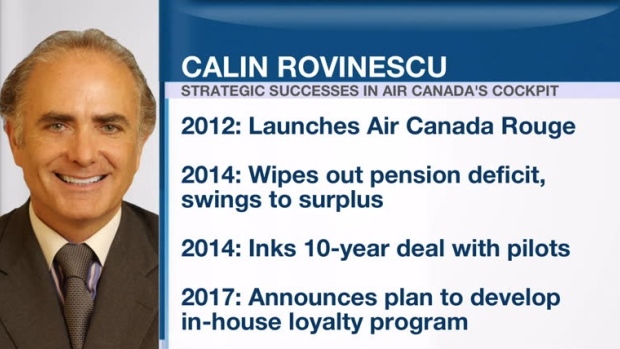Aug 1, 2017
Then and now: Inside Rovinescu’s turnaround at Air Canada

Calin Rovinescu may as well have been the target of a cruel April Fool’s joke. By the end of his first day in the top job at Air Canada on April 1, 2009, the stock was trading at an all-time low of 78 cents, the prospect of another painful trip through creditor protection loomed large, and a showdown with unionized workers over the underfunded pension was just around the corner.
It was Rovinescu’s second go-round at the nation’s flagship carrier, after helping steer it through CCAA as chief restructuring officer from 2003-04, and this time he was tasked with pulling the carrier out of a sea of red ink, drastically lowering labour costs and increasing airplane density to try to avert repeating the process.
What a difference eight years make.
Over the course of his tenure, Rovinescu has returned the company to sustained profitability, erased the pension deficit and delivered record quarterly results. Proof of his turnaround efforts was once again delivered early Tuesday, when Air Canada blew past profit expectations, set an all-time record for passengers flown and promised improvements in margins and free cash flow in the quarters ahead -- an improvement across metrics that would have seemed unimaginable when he took the top job.

Here’s a look back at how he whipped Air Canada into shape:
PROFIT:
While there have been some hiccups along the way, Air Canada has fairly consistently posted profits since 2013. The carrier has been in the black 12 of the last 14 quarters, including a record adjusted profit of $670 million in the most recent period. By contrast, Rovinescu’s predecessor, Montie Brewer, posted a net loss of $727 million in his final quarter at the company, the steepest recorded since the company exited its court-supervised restructuring.
LIQUIDITY:
In spite of the airline industry being capital intensive, Brewer left the company with a relatively paltry $1 billion of available liquidity; and, in the depths of the financial crisis, no assurance the airline would be able to shore up its cash pile. Rovinescu has steadily rebuilt the company’s liquidity over his tenure, increasing it more than four-fold to a record $4.49 billion in the most recent quarter.
ADJUSTED OPERATING MARGINS:
Air Canada posted a 4.3-per-cent adjusted operating margin to close out fiscal 2008, emblematic of the precarious position low-density seating had left the carrier in. The narrative has completely flipped for the company, with margins improving a whopping 1,280 basis points in the interim, hitting a second quarter record of 17.1 per cent.
FREE CASH FLOW:
Air Canada was mired in a cycle of negative free cash flow, burning through $438 million in the final quarter of 2008. While there has been some volatility under Rovinescu’s watch due to factors outside the airline’s control including adverse weather and fuel prices, the company most recently posted free cash flow of $305 million, an improvement of $743 million.
REVENUE PASSENGER MILES:
Air Canada has nearly doubled the number of miles passengers fly over the course of the last eight years, boasting nearly 21-million revenue passenger miles in the most recent quarter, compared to just shy of 11-million passenger miles in the fourth quarter of 2008.
AVERAGE FLEET UTILIZATION:
The company has helped drive efficiency by keeping planes flying for as much of the day as possible, in a bid to avoid having costly assets sitting idle. The average Air Canada plane is in use 10.3 hours every day – about an hour and a half longer than in 2008.
SHARE PRICE:
And investors have been handsomely rewarded during Rovinescu’s rein – shares of Air Canada are trading at an all-time high, having risen more than 2,400 per cent since rock bottom on Rovinescu’s first day.



